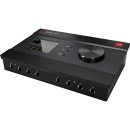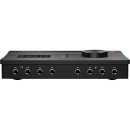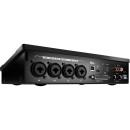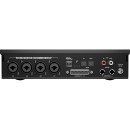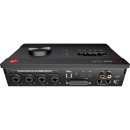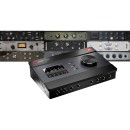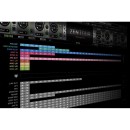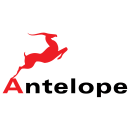Antelope Zen Tour Synergy Core Audio Interface Comprehensive Review
- Discrete 8-channel preamps with high headroom and low distortion.
- Synergy Core FX processing platform with FPGA and DSP chips.
- Real-time effects processing with over 36 included effects.
- Thunderbolt 3 and USB 2.0 connectivity for flexible integration.
- 32-bit/192 kHz AD/DA conversion for high-resolution audio.
- Four instrument/line inputs and two reamp outputs.
- Two independent headphone outputs with separate volume controls.
- Word clock I/O for precise digital synchronization.
- Color touchscreen for easy navigation and control.
- Expandable via ADAT and S/PDIF for additional inputs and outputs.
Detailed Analysis of Antelope Zen Tour Synergy Core Features
The Antelope Zen Tour Synergy Core Audio Interface is a cutting-edge device designed for musicians, producers, and audio engineers who demand high-quality audio performance and flexibility. With its compact and portable design, it is ideal for both studio and on-the-go recording sessions. The interface boasts eight analog inputs, including four world-class preamps, and eight analog outputs, offering a wide range of connectivity options for various audio equipment.
One of the standout features of the Zen Tour Synergy Core is its Synergy Core processing platform, which provides real-time effects processing with minimal latency. This allows users to leverage a vast library of analog-modeled effects that include preamps, equalizers, compressors, and more, all of which can be used without taxing your computer's CPU. This makes it an excellent choice for those seeking a powerful and efficient workflow.
Additionally, the interface supports advanced connectivity options including Thunderbolt and USB, ensuring compatibility with both Mac and Windows systems. The touchscreen interface and intuitive software controls enhance user experience, making it easy to navigate and customize settings. With its blend of high-quality audio conversion, extensive effects processing, and versatile connectivity, the Antelope Zen Tour Synergy Core Audio Interface is a top choice for professionals seeking a reliable and feature-rich audio solution.
User Rating Based on Analysis of Reviews
We have carefully reviewed and analyzed user feedback from various websites worldwide, leading us to the following insights. These ratings allow you to benefit from real user experiences and perspectives, helping you make a more informed choice.
Purchase Value
75% of users felt that the Antelope Zen Tour Synergy Core offered excellent purchase value, highlighting its robust feature set, which includes a powerful DSP and FPGA processing capability, making it a versatile tool for professional audio production. Many appreciated the inclusion of high-quality preamps and converters, which they felt justified the investment despite the premium price tag.
25% of users were dissatisfied with the purchase value, often due to the high initial cost, which they felt was not justified given their specific use cases or budget constraints. Some users also reported the need for additional software purchases to fully utilize the device's capabilities, which added to the overall expense.
Sound Quality
90% of users were extremely satisfied with the sound quality of the Antelope Zen Tour Synergy Core, praising its clarity, detail, and the professional-grade audio experience it delivers. Users often mentioned that the preamps and converters provided a noticeable improvement over their previous audio interfaces, making it a top choice for serious audio engineers.
10% of users expressed dissatisfaction with the sound quality, citing minor issues such as noise or interference. Some users felt that certain audio characteristics did not meet their expectations, especially when compared to other high-end interfaces they have used.
Build Quality
85% of users praised the Antelope Zen Tour Synergy Core for its solid build quality, noting the use of durable materials and a robust design that feels reliable and well-constructed. Many users appreciated the sleek and professional aesthetic, which complemented their studio setups.
15% of users were less impressed with the build quality, mentioning issues such as the tactile feel of knobs or switches. A few users reported concerns about long-term durability, particularly regarding the device's ports and connectors.
Ease of Use
70% of users found the Antelope Zen Tour Synergy Core relatively easy to use, with a straightforward setup process and intuitive controls. Many appreciated the helpful documentation and online resources provided by Antelope Audio, which aided in configuring the device correctly.
30% of users struggled with ease of use, often due to the complex nature of the device's software and the steep learning curve required to fully harness its capabilities. Some users mentioned difficulties with initial configuration and occasional software glitches that hampered their user experience.
Driver Stability
65% of users were satisfied with driver stability, finding the drivers to be reliable and consistent in most studio environments. Users who found the drivers stable appreciated the regular updates and support from Antelope Audio, ensuring compatibility with various operating systems.
35% of users reported issues with driver stability, experiencing occasional crashes or glitches that disrupted their workflow. Some users expressed frustration with the time it took for updates to be released, especially when new operating system versions were launched.
Customer Support
60% of users found customer support to be satisfactory, appreciating the prompt responses and the helpfulness of the support staff in resolving technical issues. Users valued the detailed guidance provided during troubleshooting sessions, which often resolved their concerns effectively.
40% of users were dissatisfied with customer support, citing long wait times and occasionally unhelpful responses. Some users felt that their specific issues were not adequately addressed, leading to ongoing frustration and unresolved technical problems.
Portability
80% of users were satisfied with the portability of the Antelope Zen Tour Synergy Core, appreciating its compact design that allows for easy transportation between different studio environments. The lightweight nature of the device was highlighted as a positive feature for mobile recording setups.
20% of users found portability to be lacking, mainly due to the need for additional equipment, such as power supplies or external accessories, which made it less convenient for on-the-go use. Some users mentioned the absence of a robust carrying case as a drawback.
A/D and D/A Conversion
85% of users praised the A/D and D/A conversion quality, noting the pristine audio fidelity and low latency that the Antelope Zen Tour Synergy Core delivers. Users often compared its performance favorably against other interfaces in the same price range, citing a significant improvement in their recordings.
15% of users were dissatisfied with the conversion quality, mentioning subtle artifacts or coloration in certain audio scenarios. Some users felt that the conversion did not match up to their expectations based on the marketing claims.
DSP and FPGA Processing
90% of users were highly satisfied with the DSP and FPGA processing capabilities, commending the power and flexibility it offered for real-time effects and plugin processing. Users appreciated the ability to offload processing tasks from their computers, enhancing overall system performance.
10% of users encountered limitations with the DSP and FPGA processing, such as compatibility issues with third-party plugins or an overwhelming interface for managing complex processing chains. A few users expressed a desire for more user-friendly software integration.
Software Integration
70% of users found software integration to be satisfactory, appreciating the comprehensive control panel and seamless integration with major DAWs. Users who were satisfied highlighted the extensive routing options and the ease of managing multiple audio streams.
30% of users experienced challenges with software integration, reporting issues with compatibility and a steep learning curve to master the software interface. Some users felt that the software could be more intuitive and user-friendly, particularly for those new to Antelope Audio products.
Latency Performance
80% of users were pleased with the low latency performance of the Antelope Zen Tour Synergy Core, noting its efficiency in live monitoring and recording situations. Users highlighted the device's ability to handle complex audio sessions without noticeable delay.
20% of users were dissatisfied with latency performance, experiencing occasional delays or dropouts in certain configurations. Some users found that achieving optimal latency required extensive tweaking, which was time-consuming and sometimes ineffective.
Preamps Quality
85% of users valued the quality of the preamps, praising their transparency and ability to capture detailed audio with minimal coloration. Many users found the preamps to be a significant upgrade from their previous interfaces, particularly in terms of noise performance and gain headroom.
15% of users were not fully satisfied with the preamp quality, citing issues with noise at higher gain settings or a lack of character compared to other boutique preamps. Some users felt that the preamps did not meet their expectations for specific recording scenarios.
Connectivity Options
75% of users appreciated the wide range of connectivity options, including multiple analog and digital inputs and outputs, which catered to diverse studio setups. Users found the flexibility of connections useful for integrating with various equipment and configurations.
25% of users found connectivity options to be insufficient, particularly those needing more specialized digital connections. Some users expressed a desire for additional I/O ports to accommodate larger setups or the inclusion of newer connection standards.
Firmware Updates
60% of users were satisfied with the frequency and relevance of firmware updates, noting improvements in device performance and feature additions over time. Users who were content appreciated the proactive approach of Antelope Audio in addressing bugs and enhancing usability.
40% of users were dissatisfied with firmware updates, often due to infrequent releases or updates that did not address their specific concerns. Some users reported experiencing new issues after updates, leading to frustration and the need for further support.
Visual Interface
70% of users found the visual interface to be clear and informative, with a responsive touch screen that provided intuitive control over various settings. Users appreciated the modern look and feel, which enhanced the overall user experience.
30% of users were dissatisfied with the visual interface, mentioning difficulties in navigating the menus or reading small text on the screen. Some users found the interface to be less user-friendly, particularly when making quick adjustments during sessions.
Durability
80% of users were satisfied with the durability of the Antelope Zen Tour Synergy Core, highlighting its sturdy construction and ability to withstand regular use in both studio and live settings. Many users felt confident in the long-term reliability of the device.
20% of users raised concerns about durability, particularly with regard to certain components such as knobs or ports that appeared less robust. A few users reported issues with wear and tear over time, leading to questions about the product's longevity.
Routing Flexibility
85% of users appreciated the routing flexibility offered by the Antelope Zen Tour Synergy Core, which allowed for complex signal routing and customization. Users valued the ability to tailor the audio paths to suit specific recording and mixing needs.
15% of users found routing flexibility to be challenging, often due to the complexity of the software interface and the learning curve associated with setting up advanced routing configurations. Some users desired a more streamlined setup process.
Compatibility with DAWs
75% of users were satisfied with the compatibility of the Antelope Zen Tour Synergy Core with various DAWs, noting stable performance and seamless integration. Users appreciated the ability to use the device across different software platforms without major issues.
25% of users experienced compatibility issues with certain DAWs, reporting problems such as inconsistent performance or the need for additional configuration. Some users found that achieving optimal integration required more effort than expected.
Value of Included Plugins
80% of users were pleased with the value of the included plugins, noting their high quality and utility in enhancing audio production. Users appreciated the variety of effects and processing options available out of the box, which added value to the overall package.
20% of users felt that the included plugins did not meet their expectations, either due to limited variety or redundancy with existing plugins in their collection. Some users desired more unique or specialized effects to complement their workflows.
Expandability
70% of users were satisfied with the expandability of the Antelope Zen Tour Synergy Core, appreciating the potential to add more effects and processing power through software updates and expansions. Users valued the future-proofing aspect of the device.
30% of users were dissatisfied with the expandability options, citing limitations in hardware capabilities that restricted the addition of more channels or features. Some users expressed a desire for more straightforward and affordable expansion paths.
Overall Satisfaction
75% of users expressed overall satisfaction with the Antelope Zen Tour Synergy Core, recognizing it as a powerful and versatile audio interface that met most of their professional needs. Users were particularly impressed by the combination of high-quality sound and advanced processing capabilities.
25% of users were not fully satisfied overall, often due to a combination of the issues mentioned, such as driver stability, ease of use, or cost concerns. Some users found that their expectations were not fully met in comparison to other options in the market.
In the following sections, we will delve into the specifications, advantages, and disadvantages of the Antelope Zen Tour Synergy Core Audio Interface. Our comprehensive review aims to provide you with a thorough understanding of this product's capabilities and help you decide if it meets your audio needs.
Pros:
- High-quality audio conversion with up to 24-bit/192kHz resolution.
- Features Synergy Core processing for real-time effects without latency.
- Expandable I/O options with multiple analog and digital connections.
- Compact and portable design suitable for mobile recording.
- Includes a wide range of built-in effects and plugins.
Cons:
- Higher price point compared to some competitors.
- Complex setup and configuration may be challenging for beginners.
- Requires a stable power source, as it is not bus-powered.
- Limited number of onboard preamps may be insufficient for larger setups.
General
| Channels of I/O | ADAT: 8 Input / 8 Output at 44.1/48 kHz 4 Input / 4 Output at 88.2/96 kHz 2 Input / 2 Output at 176.4/192 kHz S/PDIF: 2 Input / 2 Output at 44.1/192 kHz USB: 24 Input / 24 Output Thunderbolt: 32 Input / 32 Output Analog: 8 Input / 14 Output |
|---|---|
| Built-In DSP | 4x |
| Maximum Sampling Rate | 192 kHz / 24-Bit |
| Number of Microphone Inputs | 8 |
| Built-In Microphone | Yes |
| Input Level Adjustment | via Touchscreen 1x Knob |
Channels of I/O refer to the number of input and output channels available for different audio formats, providing flexibility in how audio can be routed and processed. The Antelope Zen Tour Synergy Core supports multiple formats including ADAT, S/PDIF, USB, Thunderbolt, and analog connections. For instance, it offers 8 inputs and 8 outputs via ADAT at lower sample rates, allowing for extensive connectivity with external devices. The support for 32 inputs and outputs over Thunderbolt enables high bandwidth for professional audio applications, which is crucial for multi-track recording and live sound environments.Show More
Built-In DSP signifies the presence of Digital Signal Processing capabilities integrated within the audio interface. With 4x DSP, users can apply effects and processing to their audio signals in real-time, reducing the load on the computer’s CPU. This feature is particularly beneficial for musicians and sound engineers who require high-quality effects without latency during recording or mixing sessions.
Maximum Sampling Rate indicates the highest audio quality the interface can achieve, measured in kilohertz (kHz) and bits. The Antelope Zen Tour supports a maximum sampling rate of 192 kHz at 24 bits, allowing for highly detailed recordings that capture a wider frequency range and dynamic range. This is essential for professional audio production, ensuring that the nuances of sound are preserved during the recording process.
Number of Microphone Inputs reflects the capability of the interface to directly connect microphones for recording. With 8 microphone inputs, the Zen Tour can accommodate multiple sound sources, making it suitable for recording bands, podcasts, or other multi-voice setups. This feature enhances its versatility and makes it a valuable tool for various audio production scenarios.
Built-In Microphone indicates the inclusion of a microphone within the interface, providing an additional tool for recording without needing external gear. This is particularly useful for quick recordings or capturing sounds without the hassle of setting up additional equipment.
Input Level Adjustment through a touchscreen interface allows users to easily modify the input levels for optimal recording conditions. This feature, combined with the tactile control of a knob, ensures precise adjustments can be made swiftly. Such control is important for managing audio levels effectively, helping to prevent distortion and ensuring clarity in recordings.
Signal Processing
| Pad | |
|---|---|
| High-Pass Filter | |
| Solo/Mute |
The Pad feature is designed to reduce the input signal level before it reaches the preamp stage of the audio interface. This is particularly useful when recording loud sound sources, such as drums or guitar amplifiers, to prevent distortion and clipping. In the case of the Antelope Zen Tour Synergy Core, the absence of a pad option means users will need to manage high input levels through other means, such as adjusting the gain settings or using external equipment. This could limit the range of sources that can be effectively recorded without distortion.Show More
The High-Pass Filter is a crucial tool for filtering out low-frequency noise, which can clutter the audio signal. It helps in enhancing clarity by allowing higher frequencies to pass through while cutting off unwanted low frequencies. The Zen Tour Synergy Core does not include a high-pass filter, making it essential for users to rely on post-processing techniques or external devices to clean up their audio recordings. This may require additional steps in the mixing process to achieve a cleaner sound.
The Solo/Mute function is commonly used in mixing to isolate a specific audio track or to silence it temporarily. This allows engineers to focus on particular elements of a mix without distraction. The lack of a solo/mute feature in the Antelope Zen Tour Synergy Core means that users will have to manage their audio tracks differently, potentially complicating the mixing process. They may need to resort to software solutions or external mixers to achieve the same functionality, which could affect workflow efficiency.
Connectivity
| Analog Audio I/O | 4x 1/4" TS Mic/Line/Hi-Z Input 4x Combo XLR-1/4" TRS Mic/Line Input 8x DB-25 25-Pin Line Output (on Optional Breakout Cable) 2x 1/4" TRS Stereo Output 2x 1/4" TRS Headphone Output 2x 1/4" TRS Mic/Re-Amp Output |
|---|---|
| Digital Audio I/O | 1x TOSLINK Optical ADAT Input 1x TOSLINK Optical ADAT Output 1x RCA Coaxial S/PDIF Input 1x RCA Coaxial S/PDIF Output |
| Host Connection | 1x USB-B 1x USB-C |
| Host Connection Protocol | USB 2.0 Thunderbolt 3 |
| USB (Non-Host) | |
| Sync I/O | |
| Network I/O | |
| MIDI I/O | |
| Expansion Slots |
The Analog Audio I/O section of the Antelope Zen Tour Synergy Core Audio Interface outlines the various input and output options available for connecting microphones, instruments, and other audio equipment. With a total of four 1/4" TS Mic/Line/Hi-Z inputs and four combo XLR-1/4" TRS inputs, users can easily accommodate different types of audio sources. Additionally, the eight DB-25 line outputs allow for expanded routing options, while the stereo outputs and headphone outputs provide flexibility for monitoring and playback. The inclusion of mic/re-amp outputs further enhances the versatility of this interface, making it suitable for a wide range of recording and mixing scenarios.Show More
In the Digital Audio I/O section, the interface offers a variety of digital connectivity options. The presence of TOSLINK optical ADAT input and output allows for multi-channel audio transfer, facilitating the connection to other digital audio devices. The S/PDIF input and output via RCA coaxial connectors provide additional digital interfacing capabilities. This variety ensures that users can integrate the Zen Tour with a range of digital audio equipment, enhancing the overall functionality of the interface.
The Host Connection features a USB-B and USB-C port, supporting both USB 2.0 and Thunderbolt 3 protocols. This dual connectivity option allows for high-speed data transfer and ensures compatibility with a wide array of computers and devices. However, it is important to note that there is no USB (Non-Host) connectivity, which means the device does not support direct connection to USB peripherals. Additionally, the absence of Sync I/O, Network I/O, and MIDI I/O indicates that this interface is primarily focused on audio I/O without additional synchronization or MIDI capabilities. Lastly, the lack of Expansion Slots suggests that the device is designed as a standalone unit, without options for adding extra hardware or features.
Performance
| THD | Mic: -106 dB |
|---|---|
| EIN | Mic: -128 dBu |
THD (Total Harmonic Distortion) is a measurement that indicates the level of distortion that occurs when audio signals pass through a device. In the context of the Antelope Zen Tour Synergy Core Audio Interface, a THD value of -106 dB for the microphone input signifies that the device introduces minimal distortion to the audio signal, ensuring that the recorded sound remains clean and true to the original source. A lower THD value is desirable as it reflects higher fidelity and better overall audio quality.Show More
EIN (Equivalent Input Noise) measures the amount of inherent noise that the microphone input produces when no audio signal is present. With an EIN of -128 dBu, the Antelope Zen Tour demonstrates exceptional quietness in its microphone preamps, which allows for capturing even the faintest sounds without interference from background noise. A lower EIN value is crucial for applications like studio recordings, where clarity and detail are paramount, as it helps maintain the integrity of the audio signal, especially in quiet passages.
Digital Audio
| Sample Rates | Up to 192 kHz |
|---|---|
| Sample Rate Conversion | On All Inputs (44.1 to 192 kHz) |
| Bit Depths | Up to 24-Bit |
| Clocking | Internal: |
Sample Rates: The Antelope Zen Tour Synergy Core Audio Interface supports sample rates of up to 192 kHz. This high sample rate allows for the capture of audio with greater detail and clarity, making it suitable for professional audio recording and production. Higher sample rates can also facilitate more nuanced audio processing and provide a better listening experience, especially for high-frequency sounds.Show More
Sample Rate Conversion: With sample rate conversion available on all inputs, the interface can seamlessly handle audio signals from various sources operating at different sample rates, ranging from 44.1 kHz to 192 kHz. This feature ensures compatibility across diverse audio equipment, enabling users to integrate multiple devices without worrying about mismatched sample rates, ultimately simplifying the workflow in a studio environment.
Bit Depths: The interface supports bit depths of up to 24-bit, which significantly enhances the dynamic range of the audio recordings. A higher bit depth allows for more precise representation of audio signals, reducing the likelihood of distortion and increasing the overall fidelity of the sound. This is particularly beneficial when mixing and mastering, as it provides greater headroom and detail in the audio.
Clocking: The Zen Tour features internal clocking, which ensures that the audio signals are synchronized accurately during recording and playback. Accurate clocking is crucial in professional audio applications, as it prevents issues like jitter, which can degrade audio quality. A reliable internal clock enables precise timing across all channels, resulting in a polished and coherent sound.
Audio Storage & Playback
| Media/Memory Card Slot |
|---|
The Antelope Zen Tour Synergy Core Audio Interface does not include a Media/Memory Card Slot. This feature is commonly found in other audio interfaces and allows users to directly store audio files or session data onto a removable memory card. The absence of this slot means that users will need to rely on external storage solutions, such as hard drives or cloud storage, to save their recordings and projects.Show More
This design choice could appeal to users who prioritize a compact and streamlined interface over the added bulk of a media card slot. It encourages a workflow that integrates external storage systems, potentially leading to better data management and organization practices. However, it may be a limitation for those who prefer the convenience of local storage options directly on the device.
Compatibility
| OS Compatibility | macOS 10.12 or Later Windows 10 |
|---|---|
| RAM Requirements | 4 GB, 8 GB Recommended |
| Storage Requirements | 4 GB |
| Mobile Device Compatibility |
The OS Compatibility feature indicates the operating systems that support the Antelope Zen Tour Synergy Core Audio Interface. It is compatible with macOS 10.12 or later and Windows 10. This ensures that users can integrate the audio interface seamlessly with popular operating systems, allowing for a versatile setup whether they are working on a Mac or a PC. Ensuring compatibility with recent versions of these OSs helps to maximize performance and stability during audio production.Show More
RAM Requirements highlight the memory capacity needed to run the interface effectively. A minimum of 4 GB is required, but 8 GB is recommended for optimal performance. This additional memory allows for smoother multitasking and better handling of audio processing demands, especially when working with multiple tracks and plugins. Adequate RAM is crucial for ensuring that the audio interface operates without lag or interruptions.
The Storage Requirements denote the amount of disk space necessary for the installation of the software associated with the audio interface, which is 4 GB. This storage space is essential for housing the drivers, control panel, and any additional software that facilitates the use of the interface. Sufficient storage ensures that users can install and run the software without encountering issues related to insufficient space.
Mobile Device Compatibility indicates whether the audio interface can be used with mobile devices. In this case, it is noted that the Antelope Zen Tour Synergy Core is not compatible with mobile devices. This limitation means that users will need to rely on desktop or laptop computers for their audio production needs, reinforcing its focus on delivering high-quality performance in a more traditional studio setting.
Power
| Power Requirements | AC/DC Power Adapter (Included) |
|---|---|
| AC Input Power | 18 VAC, 60 Hz |
| AC/DC Power Adapter | 18 VAC (Included) |
| Power Consumption | 25 W |
Power Requirements refer to the specifications that dictate how the Antelope Zen Tour Synergy Core Audio Interface receives and uses power. This includes the type of power adapter included with the device, which is essential for its operation.Show More
The device utilizes an AC/DC Power Adapter that is provided with the purchase. This means that the interface can convert alternating current (AC) from a wall outlet into direct current (DC), which is necessary for its internal components to function effectively. The specified AC Input Power of 18 VAC at 60 Hz indicates the voltage and frequency that the adapter is designed to handle, ensuring compatibility with standard electrical systems in many regions.
Additionally, the Power Consumption of 25 W indicates the maximum amount of power the device will draw during operation. This figure is important for users to consider, as it affects how the device will perform in relation to other equipment on the same power circuit. A lower power consumption may be preferred for energy efficiency, while a higher capacity can indicate more robust processing capabilities within the interface.
Physical
| Operating Conditions | 32 to 122°F / 0 to 50°C |
|---|---|
| Dimensions | 10 x 6.6 x 2.4" / 25.4 x 16.8 x 6.1 cm |
| Weight | 3.5 lb / 1.6 kg |
Operating Conditions refer to the range of environmental temperatures in which the Antelope Zen Tour Synergy Core Audio Interface can function effectively. With an operating range of 32 to 122 degrees Fahrenheit (0 to 50 degrees Celsius), this specification ensures that the device can be used in various settings, from cool studio environments to warmer live performance situations. Users should be mindful of these limits to maintain optimal performance and longevity of the device.Show More
Dimensions provide the physical size of the audio interface, listed as 10 x 6.6 x 2.4 inches (25.4 x 16.8 x 6.1 cm). These measurements indicate that the device is compact enough to fit in most studio setups while still offering ample functionality. The size can influence portability, making it easier for musicians and audio engineers to transport the interface for on-the-go recording or live performances.
Weight is another important specification, with the Antelope Zen Tour weighing 3.5 pounds (1.6 kg). This weight reflects its sturdy build while still being lightweight enough for portability. A lighter audio interface is often preferable for users who travel frequently or who need to set up quickly for gigs, without compromising on the quality of the audio processing capabilities.
Packaging Info
| Package Weight | 7.535 lb |
|---|---|
| Box Dimensions (LxWxH) | 11.7 x 8.9 x 6.7" |
The Package Weight of 7.535 lb indicates the total weight of the Antelope Zen Tour Synergy Core Audio Interface when packaged for shipment. This weight is significant for users considering portability and transportation. A lighter unit facilitates easy movement for musicians and audio engineers who may need to travel for live performances or studio sessions. It also affects shipping costs; a lighter package generally incurs lower fees, which can be a consideration for both retailers and end-users.Show More
The Box Dimensions (LxWxH) of 11.7 x 8.9 x 6.7 inches provide the physical size of the packaging. These dimensions are crucial for users who need to allocate space for storage or transport. Knowing the box size helps in planning how the unit will fit with other equipment or within a travel case. Additionally, appropriate dimensions can indicate how well the product is protected during shipping and storage, ensuring that it arrives in optimal condition.
Videos
Customer Questions
How do I connect the Antelope Zen Tour Synergy Core to my computer?
To connect the Antelope Zen Tour Synergy Core to your computer, use the provided USB or Thunderbolt cable. Make sure your computer has the appropriate port and install the necessary drivers from the Antelope Audio website before connecting the device.
Why is my Zen Tour Synergy Core not recognized by the computer?
Ensure that the drivers are properly installed, and the device is connected via a compatible USB or Thunderbolt port. If the issue persists, try using a different cable or port. Also, check that the device is powered on and that the firmware is up to date.
How do I update the firmware on my Antelope Zen Tour Synergy Core?
To update the firmware, connect your Zen Tour to a computer with internet access, open the Antelope Launcher application, and follow the prompts to check for and install any available firmware updates.
How can I resolve audio dropouts or latency issues?
To resolve audio dropouts or latency issues, ensure your drivers are up to date and try increasing the buffer size in your DAW. Additionally, make sure your computer meets the minimum system requirements and is not running too many applications simultaneously.
What should I do if the Zen Tour Synergy Core is not powering on?
If the device is not powering on, check the power cable and connection. Ensure that the power outlet is working and try a different outlet if necessary. If the problem persists, contact Antelope Audio support for further assistance.
How do I set up and configure the control panel for the Zen Tour Synergy Core?
Install the Antelope Launcher and Control Panel software from the Antelope Audio website. Open the Control Panel to configure settings like routing, preamps, and DSP effects. Refer to the user manual for detailed instructions.
What are the compatible operating systems for the Antelope Zen Tour Synergy Core?
The Zen Tour Synergy Core is compatible with Windows 10 and macOS 10.12 or higher. Ensure your operating system is up to date for optimal performance.
How do I connect external hardware to the Zen Tour Synergy Core?
Connect external hardware using the available inputs and outputs on the Zen Tour. Use the Control Panel to configure the routing and settings for your hardware. Consult the user manual for detailed connection diagrams and instructions.
Why am I not getting any sound from my Zen Tour Synergy Core?
Verify that the device is selected as the audio input/output device in your system settings and DAW. Check the volume levels and routing in the Control Panel, and ensure that your headphones or speakers are properly connected.
How do I access the DSP effects on the Zen Tour Synergy Core?
Open the Antelope Control Panel, and navigate to the effects section. Here, you can load, configure, and apply DSP effects to your channels. Refer to the user manual for detailed instructions on using specific effects.
